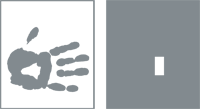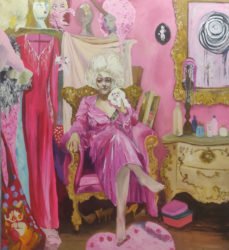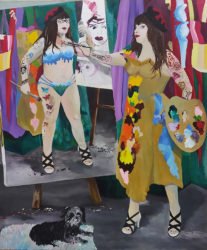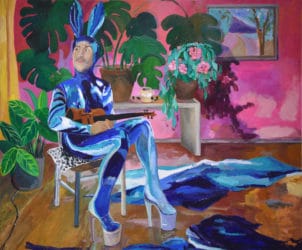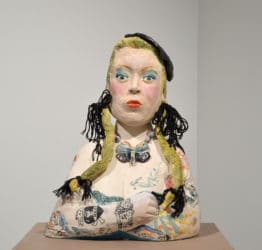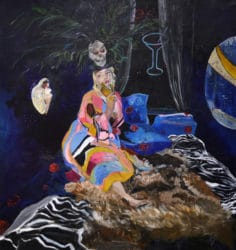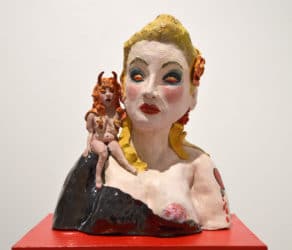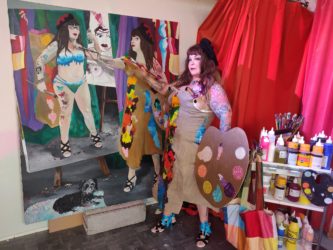Petra Innanen
PETUNIA AND THE PORTRAITS
27.10.2021 — 14.11.2021The current exhibition is Petra Innanen’s 50th anniversary exhibition. It also marks the 30th anniversary of her BFA from the Academy of Fine Arts.
The process that the series of works in this exhibition are part of started in 2014–2017 when Petra Innanen spent a lot of time working in the USA. She wanted to find a theme that did not feel forced, and that she could keep coming back to over the years. The questions of whether a subject is ‘real art’, or ‘intellectual enough’, etc. in the jargon of contemporary art had lost its relevance to her. Innanen started documenting burlesque, drag, and performance artists in their own habitats. She was already familiar with many of her models: ‘I chose my models intuitively. I liked being around these people, they look distinctive, their homes are interesting, or I found them inspiring.’ This ever transforming world of performing arts and its stunning visual characteristics was a true cornucopia for Innanen. She had already broadened her artistic practice and ventured into the field of burlesque, which she imported to Finland as an independent contemporary art form. The wider public got acquainted with burlesque in 2008 through the first Helsinki Burlesque Festival, organized by Innanen under the name Bettie Blackheart. Burlesque and Innanen’s career as Bettie Blackheart are also the subject of the 2018 documentary by Iina Terho, Full of Love – Pakomatka pakastimesta.
Petra Innanen’s documentation process for her works included observing the subjects in spaces between the everyday and their performances, very rarely on stage. She let the artists choose the locations and surroundings where they wanted to be documented. Innanen chose a focus, like the way the eye moves in space. She sometimes took dozens or hundreds of pictures. Her documentation process yielded material of around 30 artists. Mutual trust was an important part of the process, because without this kind of intimacy, it would have been impossible to document private spaces like homes and backstages. Innanen mainly worked with artists in New York, Los Angeles, Las Vegas, Berlin, and Hamburg – cities where she herself performed.
Perhaps the dimensions of trust and intimacy have led Innanen to allow time to pass between the documentation and the painting. The theme has matured in her mind for years. There were times when Innanen came close to giving up her plan for the series. In a manner of speaking, she has allowed her subconscious the freedom to push the work further and pull it back in again. The process is a slow one, and the aim was not to produce commissioned portraits. Innanen has not had the pressure of delivering the works to the artists for promotional purposes. Many of the places that she documented in the 2010s are already gone, and several of the pets have passed. In this sense, the exhibition is also a retrospective of a specific time and culture.
The works in this exhibition are not in line with a traditional portrait painting method where the artist works on the portrait in front of their model. The working material consists of photos and videos shot many years ago, conversations from different times, and memories from a myriad of situations. A portrait, like art in general, is never imitation, even if the person is portrayed here and now. The artist’s interpretations, choices, and their unique expression always make the work. In this case, the long time frame of the project has severed the artist from the original presence and perceived reality, curbed the reflex to aim for likeness, and allowed a freer approach.
The works are representational, but the painting process is abstract and guided by the subconscious. ‘Painting has felt good again for the first time in a long while. I am free of the idea that I should paint in a specific manner, or know precisely which brushstroke is the last one. Instead I feel confident that whatever is supposed to take shape will do so in the process of painting.’ Liberty in painting does not only mean not having to imitate, it also means not having to promote one’s skills by creating an illusion with details. ‘No need to fuss over making a mirror look shiny. The brushwork is important in itself.’
Petra Innanen says that she paints what she loves: spaces and people. Her works represent the tradition of milieu portraiture. The surroundings rival the model as the focus, or perhaps the model merges with the interior, camouflage style. This camouflage or masquerade dimension is an essential element in Innanen’s art, and over the years it has manifested in different ways.
The series of works in this exhibition is not ‘complete’ yet. The series will expand at its own pace. On the other hand, Innanen might not feel the need to paint portraits of all the material she has documented. The current exhibition also includes self-portraits. The self-portrait painting titled Self-portrait with a dog is not based on the same type of reference material as the other works in the series, but since it is a portrait of a performing artist and her working environment, the connection is there. The painting depicts a performance where the painter liberates herself from her working clothes and reveals an artist clad in a Magritte-inspired ‘sky bikini’ and a bottom piece inspired by English gardens. Her beret stays on. Innanen has performed the piece several times in different places, e. g. on a restaurant boat on the Seine. This painting and the ceramic self-portrait titled Keski-ikäinen naistaiteilija katsoo taaksepäin (‘middle-aged woman artist looking back’) can both be interpreted as challenging the concept of a realistic portrait and widening the scope of portrait paintings, taking a more narrative direction.
Innanen is interested in self-portraits and self-portrait series that capture the passing of time and the changes it brings. One of her favorite series is Pierre Bonnard’s self-portraits. Innanen recently exhibited at the Porvoo triennial more than ten self-portraits, spanning from a painting included in her application to the Academy of Fine Arts, to her most recent self-portraits from 2020.
All works exhibited in Petunia and the Portraits have been created during the past two years. In addition to the titles, the audience is also provided with a list of the models’ artist pseudonyms. In the painting titled Pink Pony Parlour, the burlesque artist World Famous *BOB* poses with her dog Movie Star in her home studio in Brooklyn, New York, bathed in her staple luscious colors, surrounded by her costumes. Spirit is situated in a restaurant in St. Pauli in Hamburg. The performance artist Darlinda Just Darlinda, clad in a blazing red costume, performs on the venue’s narrow stage. The ghost of the German dancer Anita Berber, whom Darlinda was investigating at the time, has also appeared in the painting. The burlesque artist Dirty Martini is portrayed in her bedroom on her bed, in the flash of the neon lights of the city at night. The portrait depicts a private person, although the gold-colored plaster hand stroking her chin and the feathered skull headpiece, along with the neon fixture, call to mind theatrical props and the cabaret stage. The painting titled Tigger! and His Heavenly Hideaway depicts a boylesque star relaxing on his private balcony in Manhattan. Scotty and His Violin portrays Innanen’s close friend and colleague Scotty The Blue Bunny sitting alert and melancholy at the same time. It is almost as if he has been caught off guard in his secret nest among the green leaves, his posture already anticipating departure. The newest of the works in this exhibition is a small painting of the burlesque world star Kitten de Ville, who has visited Finland several times in between touring the USA and Europe. The figure with platinum blonde hair, half covered by a fiery red blanket, is reflected in a mirror on a wall framed by everyday things and a feather boa from a costume. Innanen’s acute eye for the everyday and her way of bringing it to the front is an important part of these works, like it has been for all her art, from the beginning.
Petra Innanen does everything burlesque-related under the name Bettie Blackheart: producing, performing, and teaching. Bettie Blackheart is the name of a project, or actually a business. Another of Innanen’s characters is the performance project called Leila Halkeama. Leila is the personification of artist clichés that took on a life of its own, e. g. in the form of exhibition host or art history teacher online. Innanen also makes ceramics for everyday use under the label Petunia Ceramics, named after her pet name Petunia. Innanen’s different artist pseudonyms are no secret noms de guerre like many historical aliases. Scholars, artists and other celebrities in their own fields have come up with aliases to build a career that was unsuitable for their public image. A moniker might allow a university professor to write crime fiction, or a famous musician to make easy listening music.
Johanna Vakkari, 23.10.2021
English translation by Kataja Varisvaara
